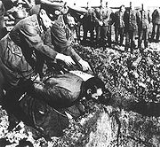
War crime
Overview
International humanitarian law
International humanitarian law , often referred to as the laws of war, the laws and customs of war or the law of armed conflict, is the legal corpus that comprises "the Geneva Conventions and the Hague Conventions, as well as subsequent treaties, case law, and customary international law." It...
) giving rise to individual criminal responsibility. Examples of such conduct include "murder, the ill-treatment or deportation of civilian residents of an occupied territory to slave labor camp
Labor camp
A labor camp is a simplified detention facility where inmates are forced to engage in penal labor. Labor camps have many common aspects with slavery and with prisons...
s", "the murder or ill-treatment of prisoners of war
Prisoner of war
A prisoner of war or enemy prisoner of war is a person, whether civilian or combatant, who is held in custody by an enemy power during or immediately after an armed conflict...
", the killing of prisoners, "the wanton destruction of cities, towns and villages, and any devastation not justified by military, or civilian necessity".
Similar concepts, such as perfidy
Perfidy
In the context of war, perfidy is a form of deception, in which one side promises to act in good faith with the intention of breaking that promise once the enemy has exposed himself .The practice is specifically prohibited under the 1977 Protocol I Additional to the...
, have existed for many centuries as customs between civilized countries, but these customs were first codified as international law in the Hague Conventions of 1899 and 1907
Hague Conventions (1899 and 1907)
The Hague Conventions were two international treaties negotiated at international peace conferences at The Hague in the Netherlands: The First Hague Conference in 1899 and the Second Hague Conference in 1907...
.
Discussions

